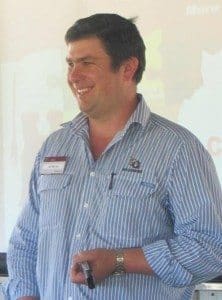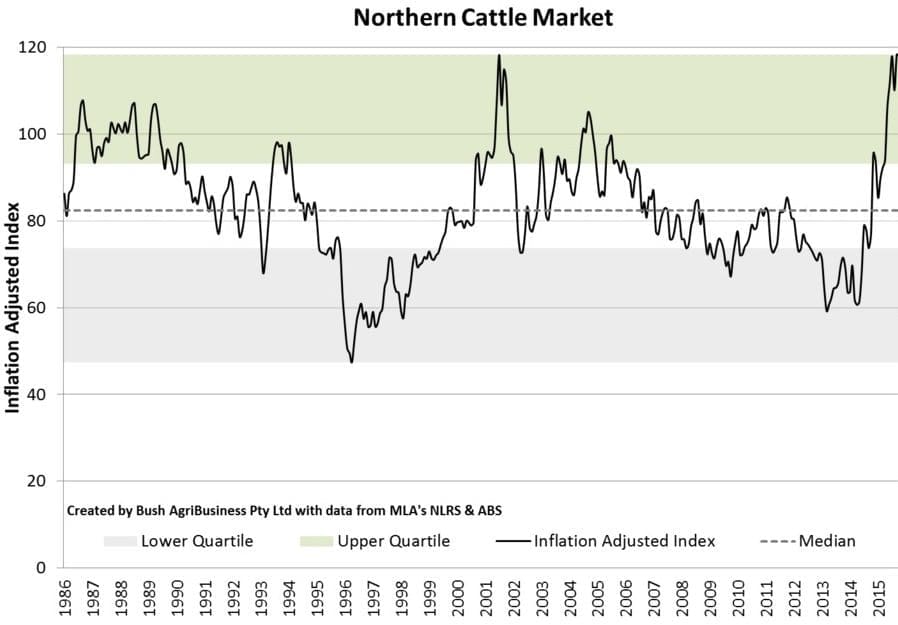 Current high beef prices are a welcome change, and have lifted the mood of the industry. However with the high prices has come the suggestion that this is the ‘new normal’ and high prices are here to stay. This, and what should be done with the profits being generated due to high prices are discussed in this contributed article by Bush Agribusiness’s Ian McLean.
Current high beef prices are a welcome change, and have lifted the mood of the industry. However with the high prices has come the suggestion that this is the ‘new normal’ and high prices are here to stay. This, and what should be done with the profits being generated due to high prices are discussed in this contributed article by Bush Agribusiness’s Ian McLean.
RECORD high beef prices, increasing demand for quality protein, decreased herd size… are we seeing a tectonic shift for the beef industry, or is this a cyclical high tide that while welcome, is only temporary?
This question is best addressed by looking at the current prices relative to longer term prices in real terms (with inflation removed), which is shown in the below graph. Two major points can be seen:
- there is an obvious cycle in the prices, and we are currently at a high point in the cycle
- the current prices are not significantly higher than they were in 2001.
This doesn’t mean prices won’t continue rising; what prices will do in the short term is anyone’s guess. However the cyclical nature of commodity prices is pervasive and high prices will not last forever, as some prominent miners will currently attest to.
A rising tide lifts all ships, and higher prices will mean increased profits. Those beef businesses in currently in production (not droughted) are benefitting from this now. For drought affected businesses sweating on a good season, higher prices mean restocking options must be thoroughly analysed, which is covered in these separate articles prepared by Bush AgriBusiness for AgForce – “Preparing for drought recovery” and “Evaluating restocking options.”
For those that are in production, who are currently achieving higher profits, a critical question is what should be done with the surplus profits being generated, the top three priorities should be:
- Pay down debt
- Re-invest in the business
- Provision for drought, retirement and succession
Paying down debt
The interest paid by the Northern beef industry over the last 15 years has exceeded the profits generated by it, so channelling increased profits into debt reduction is essential. Claims that higher prices mean beef businesses can afford more debt are dangerous and ill-informed. Debt is a long term commitment and safe levels must be based on long term business performance, not prices in the short term.
This can be where the argument that you are better paying interest than tax pops up. Well, sometimes that can be true, but most of the time it’s not. It’s true only if the return from what you have used the debt for exceeds the cost of that debt. Often it doesn’t in beef businesses, so you have to do your sums carefully. Simple arithmetic should tell you the right approach, the tax man leaves you with $0.70 in every dollar, but the debt man takes the lot! Reducing debt will result in an increase in long term after tax returns for most beef businesses.
Reinvesting in the business
An enduring fundamental of extensive beef production is that it is the lowest cost producers that will have the highest profits, through all market cycles. Having a low cost of production is more about production than it is costs, and it is the businesses that have the most productive herds, land and labour, that will have the lowest cost of production.
Where can you reinvest your surplus profits into your business to improve its long term productivity and profitability? Identifying and ruthlessly focussing on these areas will pay dividends in the long term. Re-investing in the business will also mean catching up on things that may have not been done when the money wasn’t there, such as asset replacement and maintenance. Care needs to be taken though, as our analysis has shown that costs rise and fall with prices, so cost control is important to ensure the benefits of higher prices do hit your bottom line and result in increased profits.
Provisioning
As well as debt reduction and re-investment in the business, surplus profits should also be used to provision for drought, retirement and succession. Retirement and succession are topics in themselves, but it suffices to say that funding and planning for both are generally inadequate. Drought preparedness is also a topic in itself, however financial reserves is one of the top three things businesses should aim to take into to next drought, the others being a clear plan and land condition.
Paying tax?
Avoiding tax, at all costs, is being given a high priority by some at the moment. A short term focus here can seriously conspire against long term wealth creation. Any potential investment in the business should be assessed in term of whether it increases long term productivity (herd, land or labour), reduces costs, or reduces risk and the expected returns from doing so justify the amount invested. Tax-deductibility is insufficient justification for an investment that doesn’t stack up otherwise. The path to long term wealth creation is maximising after-tax profits.
What we are seeing at the moment in the beef industry is a high tide, and not a tectonic shift. This is fantastic and should be capitalised on by producers by using the profits generated to prepare and buffer their businesses for future downturns. This will improve and stabilise long term business performance, through the full range of market and seasonal cycles. This is important because it is only when the tide goes out that you discover who’s been swimming naked!
Business Edge Workshops
Bush Agribusiness will hold a series of updated Business EDGE workshops in 2016. The Business EDGE material has been extensively updated and revised this year. While a lot of the content is timeless, the learnings from over 30 workshops have been incorporated into improving the material, which now also includes sheep enterprises as well as cattle. Dates for next year include:
- Cunnamulla, February 1-2
- Longreach, February 4-5
- Mt Isa, February 18-19
- Richmond, February 22-23
- Charters Towers, April 7-8
- Emerald, June 2-3
- Toowoomba, June 6-7.
Click here for details.

